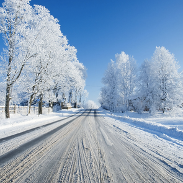As temperatures plummet again in eastern Canada, and the snow continues to fall, it’s a great time to review and share 10 important winter driving tips. Share these winter driving tips with your insurance clients and help keep everyone safe on the road.
1. Avoid the winter slip ‘n’ slide: It’s well past the time to switch your all-season tires to winter ones (this should be done before the temperature drops below 7°C). Winter tires optimize the performance and safety of winter driving. Not convinced you need them? Consider that the braking distance of a winter tire could be up to two vehicle lengths shorter than the braking distance of an all-season tire rolling at 24 km/h. There is still plenty of winter driving weather ahead.
2. Defrost your windows well: Neglecting to defrost your windows might get you to your destination faster, but it’s a dangerous habit. Plan for a few extra minutes to clean all your car’s windows well. And don’t forget to clear off the top of your vehicle—snow could slide down the windshield and obstruct your view while the vehicle is in motion.
3. Winterize your trunk: Keeping a roadside safety kit in your trunk year-round is a good idea, but winter driving conditions require extra safety equipment. Make sure you’re carrying a scraper for the windshield, a small shovel, a sandbag, candles, and warm clothing like gloves and a hat. Be prepared if you have to get out of your car in cold weather.
4. Replace worn tires: It’s important to check your tires each winter season because worn or bald tires can be dangerous. Tires have tread wear indicator bars molded into them. A solid bar of rubber across the width of the tread means it’s time to replace the tire.
5. Don’t mix and match: Mixing tires with different tread patterns, different internal constructions and/or different sizes compromises the stability of the vehicle. Ensure your vehicle is equipped with four identical winter tires.
6. Top up your fluids: Always keep your gas tank at least half full. On very cold days, the condensation in the tank can freeze and cause problems. Also, don’t forget about your windshield-washer fluid – this is also extremely important on those sunny day!
7. Pump up your tires: For every 5°C drop in temperature, tires lose one pound of air pressure. To ensure optimum fuel efficiency and prevent irregular or premature wear, tire inflation should be checked monthly.
8. See and be seen: It is critical for drivers to see and be seen in low light conditions, and when blowing snow impairs visibility. Always drive with your headlights on.
9. Take a cellphone: For long trips, don’t forget to take a cellphone in case you need to call for help. Pull over to the side of the road and stop your vehicle before making the call.
10. Drop your speed to match road conditions: The posted speed is the maximum speed under ideal conditions. In winter, it is safer to drive below the posted speed. No matter how much experience you have, the way your car will move on snow or ice always has an element of unpredictability.
Are you an insurance agent looking for a greater understanding of vehicle insurance in your province? ILScorp has online courses for ICBC Autoplan Agents in BC and an Ontario Auto Expert continuing education course. Visit ILScorp.com to learn more about our online continuing education courses for insurance agents.




